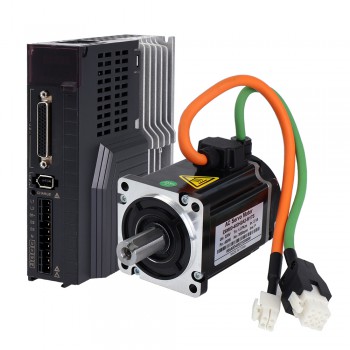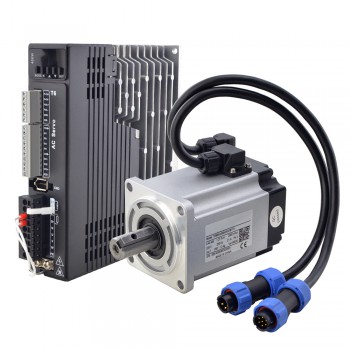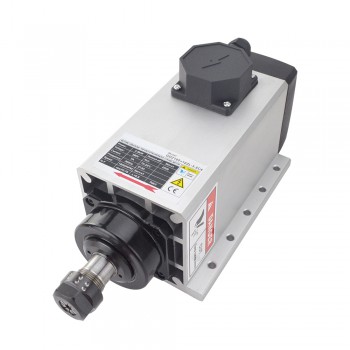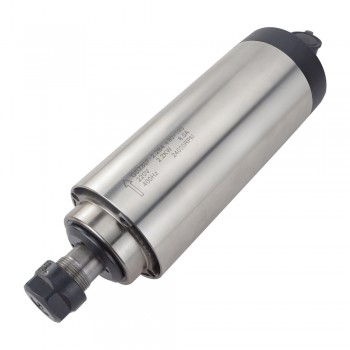Minnie's blog
1.Introduction
As the core driving component in the field of modern industrial automation, servo motors are widely used in various high-precision and high-performance control systems. According to different power supply methods, servo motors can be mainly divided into two categories: AC Servo Motor and DC Servo Motor. There are significant differences between the two in terms of working principles, control methods, application fields and performance characteristics. This article will discuss and compare the differences between AC servo motors and DC servo motors in detail.

2.Working principle
AC servo motor
AC servo motors are powered by AC power and their working principle is based on the law of electromagnetic induction. When voltage is applied to the stator winding, the servo motor will soon start rotating. The current flowing into the excitation winding and control winding generates a rotating magnetic field in the motor, and the direction of the rotating magnetic field determines the direction of the motor. When the voltage applied to any winding is reversed, the direction of the rotating magnetic field changes, and the direction of the motor also changes. AC servo motors usually include induction servo motors and permanent magnet synchronous servo motors.
DC servo motor
DC servo motors are powered by DC power and their working principle is based on the law of electromagnetic force. The DC servo motor achieves torque output through the interaction of DC current between the stator coil and the rotor coil, and its speed can be adjusted by the voltage. DC servo motors include two types: DC brush servo motors and DC brushless servo motors. Brush DC servo motors have low cost, simple structure, large starting torque, and wide speed range, but have high maintenance costs and are prone to electromagnetic interference; brushless DC servo motors have small size, light weight, large output, and fast response. , high efficiency and other advantages, suitable for various environments.
3.Control method
AC servo motor
AC servo motors usually use closed-loop control systems, which include position feedback sensors (such as encoders) and controllers. The controller realizes closed-loop control by reading the encoder signal and comparing it with the preset target position to adjust the movement of the motor. This control method makes the AC servo motor have the characteristics of high precision, high response speed and high stability.
DC servo motor
DC servo motors can use open-loop control or closed-loop control. In open-loop control, the motor speed is adjusted according to the size and polarity of the input signal. In closed-loop control, the motor performs position control through the position feedback signal returned by the encoder. The control method of DC servo motor is relatively flexible and can be selected according to specific needs.

4.Application areas
AC servo motor
AC servo motors are widely used in industrial automation, machine tools, printing, textiles, robots and other fields. Its high-speed response and high power density make it suitable for high-precision and high-performance applications. For example, in CNC machine tools, AC servo motors can achieve high-speed, high-precision positioning and cutting; in the field of robots, AC servo motors are used to achieve precise control and flexible movement of robots.
DC servo motor
DC servo motors are widely used in robotics, medical equipment, aerospace and other fields. DC servo motors have good speed and position control performance and are widely used in applications requiring precise control and response speed. For example, in medical equipment, DC servo motors are used to achieve precise surgical operations and patient monitoring; in the aerospace field, DC servo motors are used to achieve precise control and navigation of aircraft.
5.Performance characteristics
AC servo motor
AC servo motors have the characteristics of high precision, high response speed, and high stability. Its multi-phase pole form enables the motor to have better torque smoothness and operating stability. In addition, the manufacturing cost of AC servo motors is relatively low, and there are many manufacturers, so the price is relatively cheap.
DC servo motor
DC servo motors have the characteristics of high precision, high response speed, and good dynamic performance. Among them, the brushless DC servo motor also has the advantages of small size, light weight, large output, fast response, and high efficiency. However, the manufacturing technology and maintenance costs of DC servo motors are relatively high, and they are easily affected by external factors such as temperature and voltage.
6.Summary
There are significant differences between AC servo motors and DC servo motors in terms of working principles, control methods, application fields, and performance characteristics. Selecting the type of servo motor suitable for a specific application depends on the specific application requirements and performance specifications. In practical applications, it is necessary to select the appropriate servo motor type according to specific needs and conditions to achieve the best control effect and economic benefits.
Source:https://www.storeboard.com/blogs/electronics/ac-servo-motor-vs-dc-servo-motor/5853599
1.Definition of air-cooled spindle motor
An air-cooled spindle motor is a motor that uses air as a cooling medium. Its main feature is to use air flowing through the inside or outside of the motor to reduce the temperature of the motor. This cooling method is usually suitable for application scenarios that do not require excessive cooling or are more cost-sensitive

2.Working principle of air-cooled spindle motor
It mainly relies on air cooling technology, which is a method of cooling the motor through an external fan or blower. Specifically, air cooling technology installs a cooling fan on the motor shaft. When the motor is working, the fan rotates at the same time, and the generated air flow passes through the motor and takes the heat generated by the motor out of the motor through the heat pipe, thereby achieving the purpose of cooling the motor. In addition, a radiator air inlet is set at the front end of the motor, and the air flow generated by the fan is diffused to the surrounding of the motor, further enhancing the cooling effect. This cooling method does not require the motor to rely on its own methods to achieve the cooling effect, but is achieved by adding an external fan or blower. The advantages of air cooling technology include relatively economical price, easy installation, and good cooling effect, so it is widely used in real applications.
The air-cooled spindle motor is usually an AC motor, whose stator runs through three-phase AC, and the rotor is a permanent magnet. A significant advantage of this motor is that it can provide AC energy through a DC power supply, realize precise control of the motor, and solve the life problem caused by the brush. The spindle motor generally uses a photoelectric encoder to detect the speed and rotor position. The detected signal can be used as a feedback signal for vector frequency conversion control and used for magnetic field oriented control to further improve the productivity of machine tools and the utilization rate of tools.
3.The main advantages of air-cooled spindle motors
1.High speed stability: Air-cooled high-speed motors have good speed hardness characteristics and have high speed stability under load fluctuations, which significantly improves the surface finish of the workpiece.
2.Direct drive without transmission error: Air-cooled electric spindles can achieve direct drive without any transmission error, which improves processing accuracy and efficiency.
3.Good axial stability: The rotor of the air-cooled electric spindle is a rare earth permanent magnet structure, with no excitation current, low rotor heat generation, good spindle axial stability, and high workpiece processing accuracy. 4.Flexible power matching: The power can be arbitrarily matched with the thickness and length of the spindle, and the structure is extremely flexible, which can meet the application of various occasions with radial space restrictions on the spindle.
5.Significant energy-saving effect: Under the same power conditions, the energy-saving effect of the air-cooled high-speed motor is 20%~50% higher than that of other asynchronous spindle motors. The greater the power, the more significant the energy-saving effect.

4.Design basis of air-cooled spindle motors
1.The design of air-cooled spindle motors first focuses on the stability and durability of the mechanical structure. Its casing adopts a single seamless structure extruded from high-strength aluminum alloy. This design not only reduces the weight, but also improves the rigidity of the structure. In addition, the casing is also made through special heat treatment to ensure its stability and durability at high speeds.
2.In terms of bearings, the air-cooled spindle motor uses precision radial thrust rolling bearings, which contain steel balls and ceramic balls inside, and can withstand large loads and maintain high precision. In order to keep the bearings running well, high-speed special grease is used for lubrication to reduce friction and increase the service life of the bearings.
3.The design of the air-cooled spindle motor also focuses on heat dissipation performance. By adopting an efficient air cooling system, using fans or forced convection, the heat generated during the operation of the motor is quickly dissipated, keeping the motor running within a safe operating temperature range to avoid damage due to overheating.
4.In addition, the design of the air-cooled spindle motor also takes into account the wide range of product applications, including automatic tool change electric spindles, manual tool change electric spindles, five-axis heads, right-angle heads used with electric spindles, independent drilling and multi-axis electric spindle combinations, etc., to meet the needs of different industries and equipment.
With the development of science and technology, air-cooled spindle motors have also shown a significant development trend in intelligence and remote monitoring. By integrating sensors, data analysis and artificial intelligence algorithms, the operating status of the bearing can be monitored and evaluated in real time, the fault location can be accurately located, and a scientific basis can be provided for maintenance decisions.
